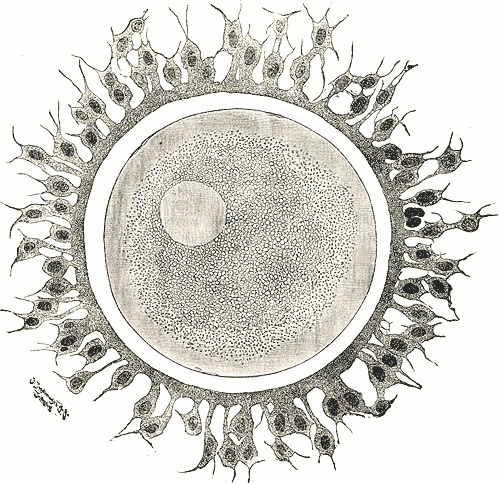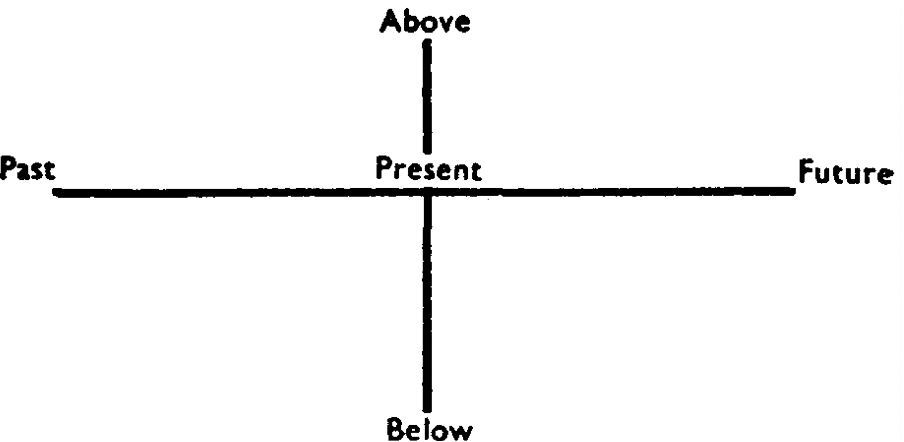This is number (27.) of our sequential postings from Volume 1 of Maurice Nicoll’s Psychological Commentaries on the Teaching of Gurdjieff and Ouspensky.
(If you are a subscriber to The Journal of Gurdjieff Studies, you can opt in or out of receiving emails from the Fragments Reading Club category.)
Links to each commentary will be put on the following Contents page, as we progress through the book:
Birdlip, January 17, 1942
Part IV.
105
THREE NOTES
(I) Work-aim has to do with the vertical line. Life-aim has to do with the horizontal line. A man can reach his life-aim. (When he does so he usually is at a loss and does not know what to do.) The supreme formulation of Work-aim is found in the Gospels where it is said: "Seek ye first the Kingdom of God and his righteousness; and all these things shall be added unto you." (Matthew VI xxxiii). The Kingdom of Heaven is above a man, not in the future of Time, but now. It is a state of man, reached internally, and so is said to be "within you".
All the teaching in the Gospels is about the Kingdom of Heaven—that is, aim is to ascend the vertical line. Here lies the possibility of a man's becoming a conscious man and this is his hidden meaning—i.e. man can rise in the vertical scale. He is where he is in the vertical line and so has one life, but he can change his position in the Universe. Life does not contain inexhaustible meaning, but the vertical line represents inexhaustible meaning—hence "vertical aim" can never be fulfilled as "life-aim" may be.
(2) The vertical line represents the line of transformation, and this line cuts at right angles the horizontal line of Time, which is the line of change. This requires to be explained. The line of transformation is at right angles to the line of change. You are all aware that Time is change. Nothing in Time remains the same—even the mountains are changing. But this change, that belongs to Time, is not transformation. The passage of Time does not transform a thing. It changes it, alters it, makes it, for example, decay or wear out. All things get older in Time. But this is not transformation. Transformation does not lie along the horizontal line, but is a necessity in the vertical line.
In this Work, the term change of Being ultimately means transformation of Being. But many changes must take place in Time before any degree of transformation can occur. The inner arrangement of a man must change—i.e. the lower centres in a man must be prepared by work before the transforming influences from higher centres can begin to reach him. The forces of transformation act from the vertical line. They act upon "substances" lying in the horizontal line in Time. If these substances are in a fit state—that is, if their qualities and quantities and arrangement are right, transformation will result.Let us find an example. You know that in the cosmos below Man, the world of living cells, certain of these cells are incomplete in their inner structure because they are capable of developing into human beings. This is transformation. Strictly speaking, transformation is the real meaning of evolution. These cells have, by union, the necessary substances, and under certain conditions undergo transformation. Through the union of these cells, a human being results. But this takes a certain time as well, first in the internal arrangement of the minute world of the two cells after union, where certain substances are selected and others are actually expelled from the united cells, and then in regard to their division and multiplication and
106
miraculous ordering subsequently. But all these changes in Time are controlled by the vertically acting forces of transformation and the result is a passage of a living thing from one cosmos to another cosmos—from the cell-cosmos to the cosmos of Man. And, as you know, similar and even more extraordinary transformation occurs in the insect world, where it would seem many experiments in transformation have been made.
But a human being, a man, is again incomplete, and so feels the desire for union. Those cells in him which are incomplete communicate their desire for completeness and this forms one desire for union. But a man is not merely the reflection of the cell-cosmos. He feels incomplete in other ways, if he possesses magnetic centre. Now, you will understand that in this vertical line, if we could move a thing upwards, it would at once become transformed. Whereas if we could move a thing in Time, it would merely change—get younger or older according to the direction in which we moved it.
(3) In this horizontal line representing our lives we live and move. But where this horizontal line cuts the vertical line marks the point of our level of Being, and what we experience in Time is the result of our level of Being. Being is vertical to Time, and is a man's "stature". There is an interesting phrase used in the Acts about this idea. Paul says that God is not far from each one of us: "For", he says, "in Him we live, and move, and have our being." We live and move in Time but we have our Being in this vertical line which descends from the highest to the lowest. But ordinarily we think that our origin lies in the horizontal line in Time—namely, the past—and we do not understand that our origin is also vertical to this line. You have heard the expression that essence comes from the stars and when we come to talk about the Ray of Creation you will see plainly that the stars signify an order of worlds far above the earth in vertical scale. That is to say, essence in its origin—and you must remember that at birth we are essence—lies above us. The point where it enters into Time is the moment of our birth. The point where it leaves Time is the moment of our death. In between these two points lies our life in Time, where a development of essence is possible, and where, apart from this, personality is formed inevitably. That is, personality is formed in Time, and belongs to Time, whereas essence enters Time and leaves Time. Essence is beyond Time. The quality of essence belongs to the vertical line drawn at right angles to Time—that is to say, essential being belongs here. Speaking in general, a man's being is made up of everything in him, but a man's essential being depends on the development of his essence—what is real in him. This is what he is. In the phrase quoted above, from the Acts, when it is said "in Him we have our being", the Greek έσμέν means we are—i.e. "in Him we are." Being is what we are and, as I said last time, the vertical line represents where a thing is in the total Universe of meaning. A thing is where it is essentially. Being is from the verb to be which signifies being. It is what you are. God is defined in the Old Testament
107
as "I am that I am". When Moses asked the name of God, the reply was: "I am that I am". In life we try to be like something; we are always trying to be like something, always trying to imitate, always pretending to be something we are not. If a man were to find real 'I' in himself, which lies vertically above him in the scale of being, he would no longer be like anything but would be himself, what he is. In this vertical scale the being of everything lies, the being of a stone, the being of a tree, the being of a dog, the being of organic life, the being of the earth, the being of the sun, the being of the starry galaxy. This is nothing to do with Time. But to each level of being there is a scale in Time allotted, for the perfection of being lies in Time. We have our allotted span of life in Time appropriate to changing our being. For, as you know, from the standpoint of this Work, the whole Universe, on every scale and in every degree, is evolving. This Work does not teach that we live in a dying Universe, but in an evolving one, and everything in it, in every different world or cosmos, is seeking its evolution—that is to say, it is seeking to rise higher and higher in the level of being. And in every cosmos something is working. We know directly that in the cosmos of Man to which we belong, in this cosmos, something is working. This Work itself is a sign of it. The whole idea of esotericism is a sign of it. You are taught that Man is a self-evolving organism, that there is and always has been a special kind of teaching that deals with this inner evolution, and you are taught that there are conscious men who have attained this possible inner evolution.
Now let us turn to the Cosmos of Cells which is below Man in order to see whether there is anything similar here. Three kinds of cells with very distinct differences exist in Man:
(1) Brain-cells,
(2) Sex-cells,
(3) Body-cells—namely, the cells composing the organs, the skin, the muscles, which are all different but in a sense similar.
(1) Brain-cells are shut off from the body in a special way with bony coverings (skull and vertebrae), they are cushioned by water- jackets from shock, they are completely isolated from the bodily organs, they get the best nourishment and in starvation shew the least changes. Brain-cells live for the life-period of Man—i.e. they are immortal in respect to the ordinary period of cell-life which is very roughly in the order of 24 hours. That is, they live 80 years of Man's time, which is 2,400,000 years of their own time. They can be compared with the circle of conscious humanity, with those who have reached immortality.
(2) Sex-cells are incomplete internally in a certain way and they have a destiny quite different from that of the Body-cells.
(3) Body-cells, the cells composing the liver, the stomach, etc. are constantly dividing in periods shorter and longer than 24 hours— maybe months—yet of that order of period of Time. These cells can be compared with mechanical humanity, which is under certain laws and must submit to them in one way or another.
108
We can arrange these cells in vertical order:
just as we arranged Man in vertical order, Conscious Man, Balanced Man, and Mechanical Man. At present I only wish to draw attention to this correspondence between the cosmos of Man and the cosmos of Cells. We will speak of the cosmos of Atoms and special kinds of Atoms later. What I wish to indicate is that "something is working" in each cosmos, or, if you prefer, that what exists in the cosmos of Man must in some corresponding way exist in the cosmoses below him, for every cosmos is under the same laws.






